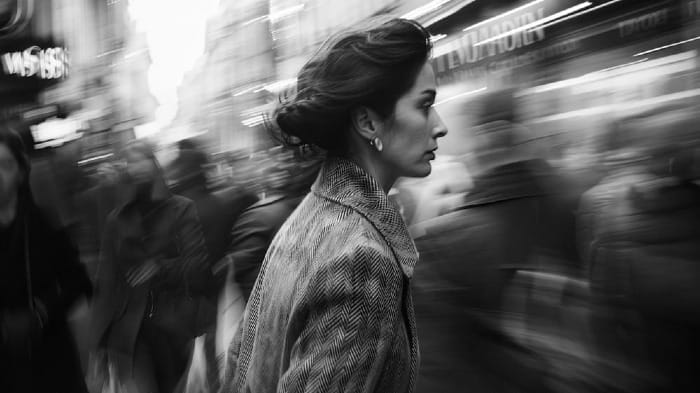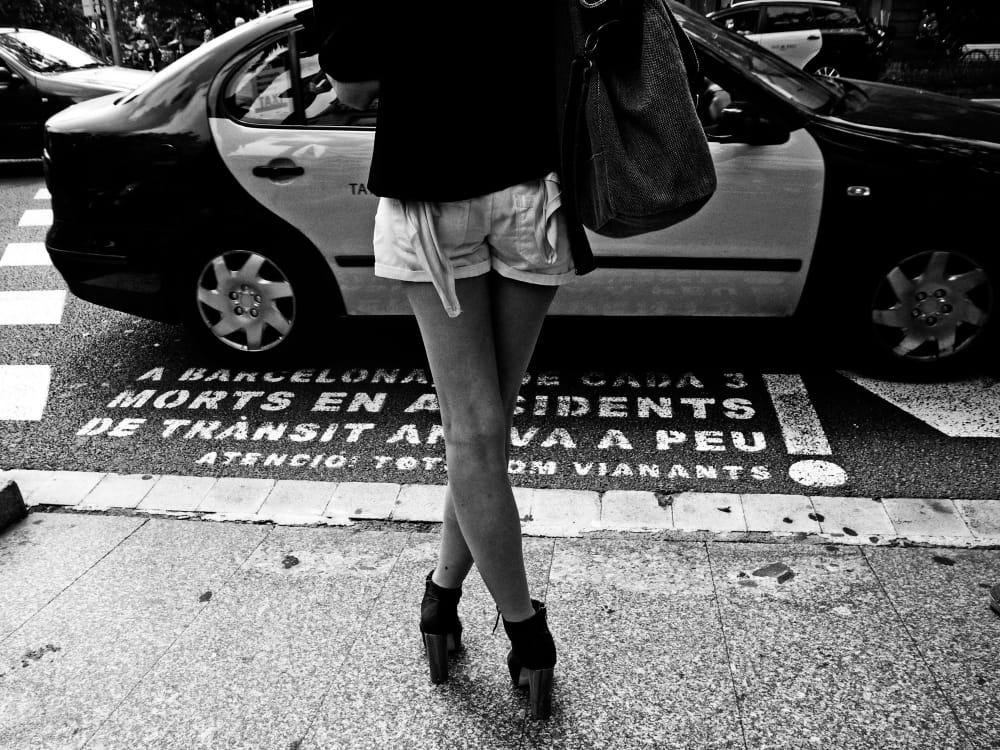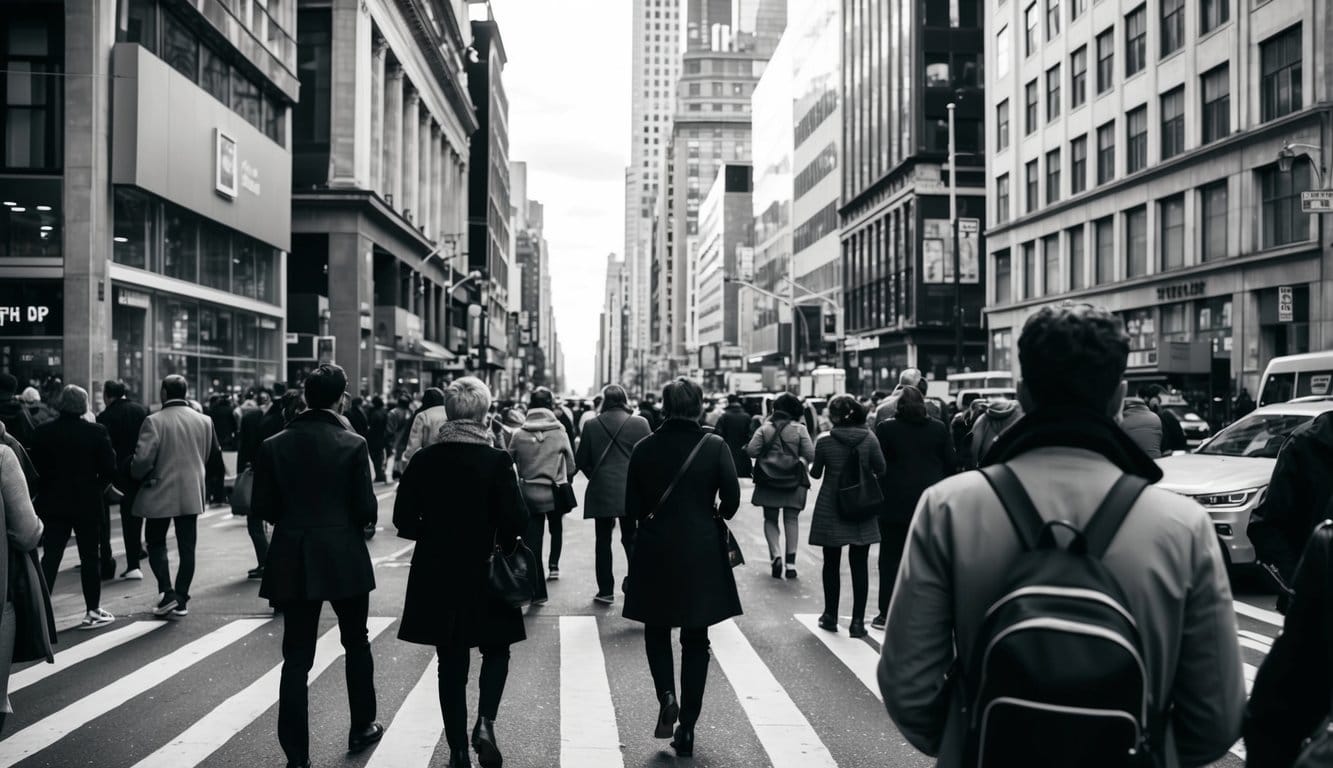Street Photography: Uncovering Prime Urban Spots for Compelling Shots

Street photography freezes moments of everyday life in public spaces. It shows the world as it is, with no setup or posing. This art form began in the early 1900s and grew with the rise of small cameras.

Street photography captures the pulse of society, recording human behavior and interactions in public settings. It can reveal hidden beauty in mundane scenes or highlight social issues through candid images. The genre often uses wide-angle lenses to include more of the surroundings.
Many photographers look up to Henri Cartier-Bresson as a master of street photography. His work shaped how we see this type of image-making today. Street photos can be taken anywhere people gather, from busy city streets to small town squares.
Foundations of Street Photography
Street photography captures candid moments in public spaces. It requires skill, timing, and an understanding of ethical and legal boundaries.
History and Influential Photographers
Street photography emerged in the early 20th century. Henri Cartier-Bresson was a pioneer who shaped the genre. He coined the term "The Decisive Moment," which became a key concept.
Walker Evans documented American life during the Great Depression. His work showed the power of street photography to capture social realities.
In more recent times, Martin Parr brought color and humor to street scenes. Daido Moriyama's gritty black-and-white images of Tokyo streets influenced many photographers.
Understanding the Decisive Moment
The Decisive Moment is about capturing a fleeting instant that tells a story. It requires keen observation and quick reflexes.
Photographers must anticipate action and be ready to shoot. This skill comes with practice and patience.
Compact cameras like the Leica made it easier to capture these moments. They allowed photographers to blend in and shoot quickly.
Ethics and Legal Considerations
Street photography often raises questions about privacy. Photographers must balance artistic expression with respect for subjects.
In public places, photography is usually legal. But laws vary by country and location. Photographers should know local rules.
Some street photographers ask for permission, while others prefer candid shots. Either way, being polite and respectful is key.
Selling or publishing street photos may require releases from recognizable subjects. This protects both the photographer and the subject's rights.
Gear and Technique

The right gear and technique are key for successful street photography. Proper equipment and settings help capture candid moments in urban environments.
Choosing the Right Equipment
Street photographers often prefer compact cameras that don't draw attention. Mirrorless cameras are popular for their small size and quiet operation. Many pros use Leica rangefinders for their reliability and image quality.
A good all-around lens is essential. The 35mm focal length offers a natural perspective close to human vision. Wider lenses like 28mm work well for busy scenes. Longer focal lengths can isolate subjects from a distance.
Weather-sealed gear helps when shooting in various conditions. A comfortable camera strap allows quick access. Extra batteries and memory cards are crucial for long shooting sessions.
Camera Settings and Techniques
Fast shutter speeds freeze motion in busy streets. 1/250th of a second or faster is often needed. Higher ISO settings may be necessary in low light. Many street photographers use aperture priority mode to control depth of field.
Zone focusing speeds up shooting. The photographer pre-focuses to a set distance and shoots quickly without autofocus. This technique works well with wider lenses and smaller apertures.
Burst mode can capture fleeting expressions or gestures. Silent shooting modes on newer cameras help remain unobtrusive.
The Role of Prime Lenses
Prime lenses offer several advantages for street photography. They're typically smaller and lighter than zoom lenses. This allows for more discreet shooting and less fatigue during long walks.
Prime lenses often have wider maximum apertures. This enables shooting in low light and creates a shallow depth of field when desired. The fixed focal length encourages photographers to move and compose shots more carefully.
Popular prime lens choices include 28mm, 35mm, and 50mm. Each offers a distinct perspective. Using one focal length consistently helps develop a unique visual style over time.
Composition and Aesthetics

Street photography relies on strong visual elements and storytelling to capture urban life. Photographers use various techniques to create compelling images that reflect the energy and character of public spaces.
The Elements of Visual Language
Leading lines guide the viewer's eye through street scenes. Buildings, roads, and crowds form natural lines that add depth and interest. Light and shadow play crucial roles, too. The harsh midday sun creates stark contrasts, while softer evening light adds mood.
Framing subjects with doorways or windows draws focus. The rule of thirds helps balance compositions. Placing key elements along imaginary grid lines creates visual harmony.
Color can make images pop or set a specific tone. Bold hues grab attention, while muted palettes convey different moods. Texture adds tactile qualities, bringing scenes to life.
Capturing Public Life
Street photographers aim to document candid moments of everyday life. This requires patience, observation, and quick reflexes. Waiting for the right moment is key.
Capturing genuine expressions and interactions reveals human stories. Photographers often blend into the background to avoid influencing the scene. Some use a technique called "shooting from the hip" to stay unnoticed.
The juxtaposition creates interest by placing contrasting elements side by side. A businessman next to a homeless person, for example, can make a powerful statement about urban life.
Creative Approaches and Styles
Street photographers develop unique styles to stand out. Some focus on minimalism, using negative space to highlight subjects. Others embrace chaos, filling the frame with action and detail.
Unconventional angles add visual interest. Shooting from low or high vantage points offers fresh perspectives on familiar scenes. Reflections in windows or puddles create surreal effects.
Motion blur conveys energy and movement. Slow shutter speeds turn bustling crowds into abstract streaks of color. In contrast, freezing fast action with high shutter speeds captures split-second moments in sharp detail.
Engagement and Interaction

Street photography involves connecting with people and places. It requires skill in approaching strangers and capturing candid moments. Photographers must balance artistic vision with respect for subjects.
Photographing People and Strangers
Capturing candid moments of people is key in street photography. Photographers need to be quick and observant. They should look for interesting expressions, actions, or interactions.
When photographing strangers, it's important to be respectful. Some photographers prefer to ask permission first. Others aim for candid shots without disrupting the scene.
Hand-eye coordination is crucial. Photographers must be ready to frame and capture fleeting moments. Practice helps improve timing and composure.
Navigating Personal Space and Boundaries
Street photographers must be aware of personal space. Getting too close can make subjects uncomfortable. Using a longer lens allows for more distance.
Different cultures have varying views on photography in public. It's important to research local customs and laws. Some places restrict photographing children or certain buildings.
If someone objects to being photographed, respect their wishes. Delete the photo if asked. Being polite and understanding helps avoid conflicts.
Taking Street Portraits
Street portraits involve engaging directly with subjects. Photographers should approach people confidently but kindly. A smile and a brief explanation of the project can help.
Ask for permission before taking a portrait. Explain how the photo will be used. Some photographers offer to send copies to their subjects.
Natural-looking portraits help subjects feel at ease. Light conversation can relax people. Encourage natural poses rather than stiff, formal ones.
Framing and background are important in street portraits. Look for interesting settings that complement the subject. Simple backgrounds often work best to keep focus on the person.
How to Find the Best Locations for Street Photography in Any City

Finding great spots for street photography takes some exploration. Start by researching popular areas online before your trip. Look for busy markets, interesting neighborhoods, and lively public spaces.
Walk around and observe the city's rhythm. Notice where people naturally gather and interact. Parks, plazas, and transportation hubs often provide good opportunities.
Visit at different times of day to see how the light and activity levels change. Early morning and late afternoon often offer the best lighting for photos.
Local events like festivals or street performances can create exciting scenes to capture. Check city calendars to find upcoming happenings.
Don't overlook less obvious locations. Industrial areas, alleyways, and quiet side streets can yield unique shots.
Pay attention to interesting architecture, street art, or eye-catching storefronts that could serve as backdrops. These elements add visual interest to images.
Safety is important. Research any high-crime areas to avoid and always be aware of your surroundings while shooting.
Talk to locals for insider tips on photogenic spots. They may know of hidden gems tourists often miss.
Be open to wandering and getting a little lost. Some of the best photo opportunities arise unexpectedly when exploring a new place.
Post-Production and Presentation

Street photography captures raw moments, but thoughtful editing and presentation can enhance the impact. Careful post-processing brings out the essence of an image, while high-quality prints showcase the photographer's vision.
Editing for Street Photography
Street photography editing aims to preserve authenticity while improving visual appeal. Adjust exposure and contrast to make subjects stand out. Use cropping sparingly to tighten the composition.
Color grading can set the mood. Many street photographers prefer black and white for a timeless look. Adjust highlights and shadows to add depth.
Remove distracting elements carefully. Minor retouching is acceptable, but avoid altering the scene's reality. Noise reduction and sharpening can enhance image quality, especially for low-light shots.
Develop a consistent editing style across a series of images. This creates a cohesive body of work. Presets can speed up workflow but tailor adjustments to each photo.
Creating Compelling Art Prints
High-quality art prints showcase street photography's artistry. Choose archival paper and inks for longevity. Matte finishes often suit the genre's gritty aesthetic.
Print size affects viewer experience. Large prints immerse viewers in the scene. Smaller prints encourage intimate viewing. Consider the image's details and intended display location.
Framing complements the photograph. Simple black frames are classic for street scenes. Float mounting creates a modern look. White mats draw focus to the image.
Limited edition prints add value for collectors. Number and sign each print. Include a certificate of authenticity. Online galleries expand their reach, but physical exhibitions offer tactile engagement with the artwork.
Frequently Asked Questions
Street photography raises many common questions about techniques, ethics, and best practices. Photographers often seek advice on camera settings, consent, capturing candid moments, monetization, influential works, and ethical considerations.
What are the best camera settings for street photography?
For street photography, use a fast shutter speed of at least 1/250s to freeze motion. Set your aperture between f/8 and f/11 for a good depth of field. Use Auto ISO to adjust for changing light conditions quickly.
Keep your camera in aperture priority or shutter priority mode. This allows for quick adjustments while maintaining control over key settings.
How can photographers obtain consent for street photography portraits?
Approach subjects politely and explain your project. Ask for permission before taking close-up portraits.
Be prepared to delete photos if someone objects. In some cases, offering to send a copy of the photo can help build trust.
What techniques do photographers use to capture candid moments in urban environments?
Blend into the environment by dressing casually and using a small, discreet camera. Anticipate moments by observing people's behavior and movements.
Use zone focusing to pre-focus your camera. This technique allows for quick shots without drawing attention to yourself.
How do successful street photographers monetize their work?
Sell prints or digital downloads through online platforms. Offer workshops or photography tours in urban areas.
Submit work to stock photography websites. Create photo books or collaborate with brands for commercial projects featuring street scenes.
Can you recommend some influential street photography books for inspiration?
"The Americans" by Robert Frank is a classic that captures 1950s American life. "The Decisive Moment" by Henri Cartier-Bresson showcases the art of timing in street photography.
"Street Photography Now" by Sophie Howarth and Stephen McLaren features contemporary photographers. These books offer diverse perspectives on the genre.
What are the ethical considerations involved in street photography?
Respect people's privacy and dignity. Avoid photographing vulnerable individuals or those in compromising situations.
Be mindful of cultural sensitivities when shooting in different communities. Consider the potential impact of your images on the subjects and their surroundings.





